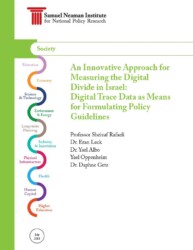בשנים האחרונות, הולכת וגדלה חשיבותו של המחקר בנושא הפער הדיגיטלי לצורך קביעת והערכת מדיניות. במשך שנים, נעשה שימוש במגוון רחב של שיטות מחקר כמותיות ואיכותניות למדידת פער זה בין מדינות וקבוצות אוכלוסייה שונות ולזיהוי הגורמים העיקריים המשפיעים עליו. שיטות אלה כוללות סקרים, ראיונות מובנים, שאלונים פתוחים וניתוח מדדים.
אחת המלכודות העיקריות של כל שיטות ה”דיווח העצמי” היא הנטייה לסוגים רבים של הטיות דיווח. מחקר זה מציע גישה חדשנית לזיהוי, מדידה והדמיה ויזואלית של הפער הדיגיטלי באמצעות ניתוח נתוני “עקבות דיגיטליים”. נתונים אלו הינם רישומים של פעולות הנעשות דרך מערכות מידע מקוונות היכולים להיווצר כתוצאה מפעילות אנושית (פוסטים ברשתות חברתיות, פעילות חיפוש במנועי חיפוש ובויקיפדיה, מסרים מידיים וכו’) או כתוצאה מפעילות מכונה (ניצול רוחב פס, נפח תעבורה של ביטים, לוגים של פעילות וכו’) .
השימוש במדדי עקבות דיגיטליים יחד עם שכבות מידע נוספות (נתוני סקרים, מדד ה-ICT הלאומי של ישראל וכו’) יוכל לשמש לשם גיבושם של מדדים שונים ברמה מרחבית, עיתית וסקטוריאלית מפורטת. ממצאי המחקר ישמשו לשם גיבוש והערכת מדיניות עבור מקבלי ההחלטות בנושא הפער הדיגיטלי.


